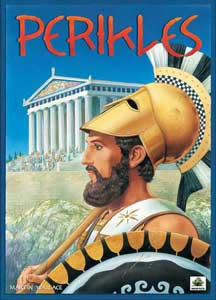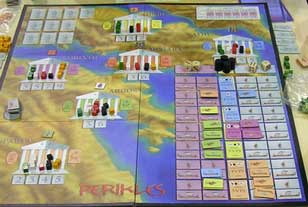Pevans
Periklesreviewed by Pevans |
 Perikles is the 2006 production from the brain of Martin Wallace and the imprint of Warfrog. The game is about warring city states in Ancient Greece – specifically, the Peloponnesian War between Athens and Sparta. Over three turns, the players command the forces of half a dozen cities in a series of battles. However, players first have to be elected to lead each city. As they will get victory points for winning elections as well as battles, this is no hardship. It means the game is as much about politics as it is about war.
Perikles is the 2006 production from the brain of Martin Wallace and the imprint of Warfrog. The game is about warring city states in Ancient Greece – specifically, the Peloponnesian War between Athens and Sparta. Over three turns, the players command the forces of half a dozen cities in a series of battles. However, players first have to be elected to lead each city. As they will get victory points for winning elections as well as battles, this is no hardship. It means the game is as much about politics as it is about war.
Starting at the beginning, the game is produced to the usual standard: a good solid box, mounted board, chunky card tiles and wooden cubes and other markers. Over a partial map of Greece, the board shows the playing areas used in the game. In particular, there are spaces for each city state (in its colour) plus a grid for the disposition of forces at each turn’s battles. Each city has tiles (in the appropriate colour) for its hoplites and triremes. Sparta and Athens have noticeably more than the others do, including some very strong hoplites for Sparta and some very strong triremes for Athens.
Players each get a pile of wooden cubes and leader counters in their selected colour. The cubes are used to show players’ political influence in each city. At the start of the game, all players get two cubes in each city and then place another two each as their starting influence. Here players have to make their first decisions – which cities they want to have most influence in. Athens and Sparta have the biggest armies, which makes them the most useful for winning battles. However, players will usually get more points as leaders from the other cities. Hmm, more information is needed here.
At the start of each turn, ten Influence tiles are dealt out for players to choose from. Most of the Influence tiles are for a specific city and are in the city’s colour – there are some ‘Any City’ tiles. Players take it in turns to take a tile (which is replaced), but can only take one tile in any colour. Tiles generally show two pottery shards, allowing the player to place two influence cubes in the appropriate city – the ‘Any City’ tiles have only one pottery shard and allow only one cube to be placed. Some of the tiles show either an ‘Assassin’ or ‘Candidate’ figure instead of the second shard. An Assassin allows the player to remove a cube from any city. The Candidate takes us into the next stage of the turn.
Once all players have five Influence tiles, they start proposing candidates for leadership of each city. Some candidates will already have been selected using Influence tiles. Players now take it in turns to nominate a cube – of any colour – until there are two candidates in each city. The winner of each election is the nominee with the most remaining influence cubes in the city. Ties are broken in favour of the cube nominated first. The winning player then loses as many influence cubes from the city as the defeated candidate has.
Obviously, players are looking to win the elections and become leaders. However, there are lots of tactical options in how the elections are won – and strategic considerations as to which elections you want to win. If you’re going to win an election, it’s worth nominating an opponent who has only a few cubes so that you don’t lose many. Conversely, those who aren’t going to win the election would prefer that the winner loses lots of cubes. And the player with the most cubes may not win the election if two other players are nominated first. You can immediately see the usefulness of Candidate Influence tiles: they let you steal a march in nominating candidates.
The strategic reasons for winning the leadership of specific cities include the battles that are to be fought that turn. At the start of a turn, seven location tiles are laid out for all to see – there are 21 in all, so all of them are used in each game (and the game’s over when they run out). Each location belongs to a city and it’s in the interests of the current (and past) leader not to lose the battle. If the location is won by an attacker, the defeated city takes a marker that reduces the value of being leader of the city.
Once we have determined who the leaders of the cities are, they take control of the appropriate military forces. (If anyone wasn’t elected leader of anywhere, they get the Persian troops and can try to win battles with them.) In turn, players deploy a couple of units by placing them (face down so that their strength is hidden) on the attack or defence side of a location. This is controlled by the influence tiles: each time they place units, players hand back one of their tiles. However, all tiles showing two pottery shards must be used before any one-shard tiles. This gives another tactical option: the one-shard tiles are less useful for gaining influence, but can give a player the advantage of deploying troops last. Players can also pay influence cubes from a city to deploy extra troops.
As soon as all players have their troops in place, players resolve the battles one at a time. Most battles are fought over two rounds: land and sea, though they can be in either order. The strengths of the sides give the odds of the fight and the combat table gives the die roll either side must get (on two dice). Each time the attacker or defender rolls the required score, one of the four Battle tokens moves to that side. First to two tokens wins the round. The second round (if there is one) is fought the same way, but the winner of the first round starts with one token on their side. Winning the battle gets the winner the location card and the victory points shown on it (some battles are worth more than others!).
After all seven battles have been fought, the turn is over. After three turns, the game is over. Players score points for the battles they’ve won, according to the location tiles they hold. They get points for their past leaders, according to the final values shown for each city. And they get a point for each remaining influence cube in a city. Whoever has the most points wins the game, of course.
 The multi-layered nature of the game makes Perikles an interesting challenge. Placing your influence correctly to win the leadership of cities is relatively straightforward. But you need to think about winning some battles. This makes Sparta and Athens – with their large forces – very attractive, even if you don’t get so many points for being leader of these cities. However, most of the battles are for locations belonging to these two cities. Losing these reduces the value of being leader, so you need to weigh up the advantages and disadvantages of attack versus defence. There’s also a special rule that the game ends early if either Athens or Sparta suffers four defeats. Another tactical option.
The multi-layered nature of the game makes Perikles an interesting challenge. Placing your influence correctly to win the leadership of cities is relatively straightforward. But you need to think about winning some battles. This makes Sparta and Athens – with their large forces – very attractive, even if you don’t get so many points for being leader of these cities. However, most of the battles are for locations belonging to these two cities. Losing these reduces the value of being leader, so you need to weigh up the advantages and disadvantages of attack versus defence. There’s also a special rule that the game ends early if either Athens or Sparta suffers four defeats. Another tactical option.
Remember, too, that cubes still on the board at the end of the game are worth points, so just getting cubes into play is worth doing. Of course, tactically, it may be more valuable to take an Assassin or Candidate Influence tile even if these only let you place a single cube. Though these tiles may then give you an advantage when it comes to deploying troops for the battles… This is a subtle game that repays carefully planning, but beware of other players: their machinations can (and will!) throw off your plans. Nothing new there, then.
Perikles is another cracking game from Martin Wallace. It offers players lots of tactical options within their overall strategy. This means lots of decision-making and lots of interplay with the other players. Which make for a great game. Surprisingly, I found the game a little dry, despite all this. With this caveat, I recommend the game. It gets 8/10 on my highly subjective scale.
Perikles was designed by Martin Wallace and published by Warfrog. It is a strategy board game for 3-5 players, aged 13+, and takes about 2 hours to play.
This review was first published in To Win Just Once issue 72, February 2007.